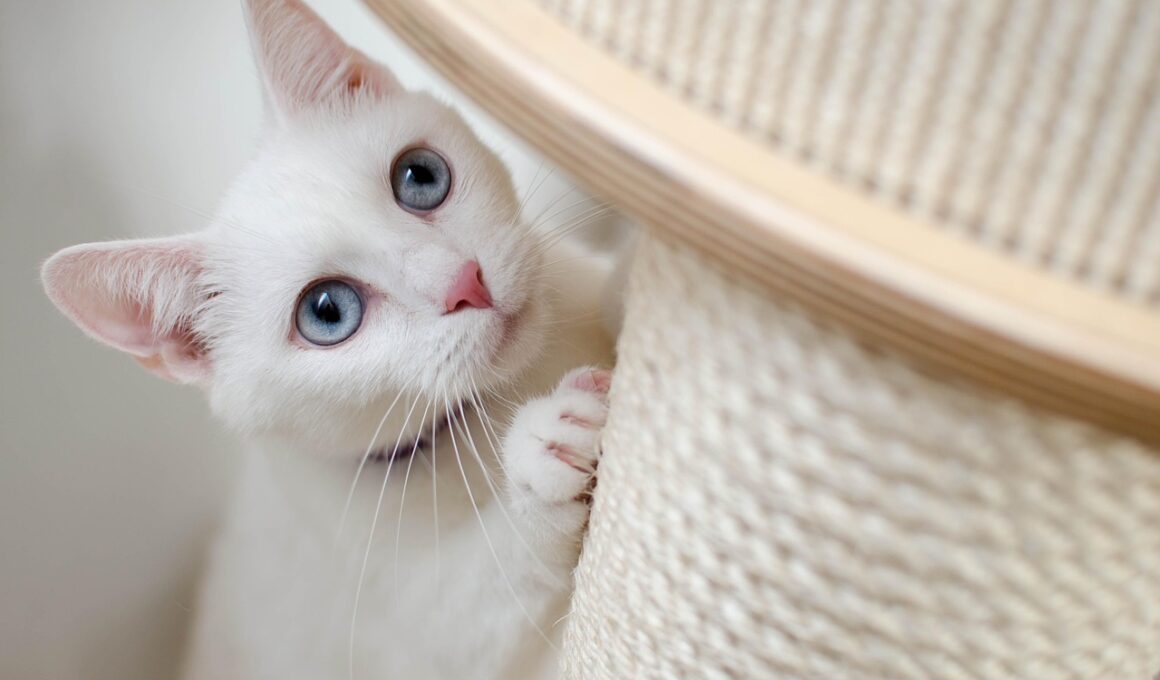How to Encourage Positive Behavior in Kittens
Understanding kitten behavior is crucial for fostering a long, happy relationship with your furry friend. Young kittens may exhibit various behaviors as they explore their surroundings. It is important to recognize that many of these actions are natural and instinctual. From playfulness to curiosity, these traits help them learn important skills. When kittens engage in behaviors that might seem negative, remember they are understanding their environment and testing boundaries. For example, it is common for kittens to scratch furniture or chew on cords. Instead of punishing them, provide appropriate alternatives. This could include scratching posts, chew toys, or distractions that redirect their energy. A well-structured environment supports positive behavior while allowing kittens to express themselves. Moreover, socialization is vital at a young age. Engage them in interactive play, exposing them to various sights, sounds, and smells. This helps them develop social skills and adaptability. Seeing other cats or friendly dogs during early stages can significantly benefit their future interactions. By properly stimulating their minds and bodies, you can minimize negative behaviors and bring joy into your lives.
One essential aspect in understanding kitten behavior is recognizing body language. Kittens communicate their feelings through specific signals and postures. For instance, a twitching tail or flattened ears can indicate excitement or fear, respectively. Learning to observe these subtle cues can greatly enhance your bonding experience. When a kitten displays signs of being overwhelmed or overstimulated, it’s crucial to allow them a retreat to a safe space. This helps to ease their stress, promoting positive emotional health. Similarly, when a kitten purrs, it commonly signifies comfort and happiness. Encourage this state by providing affection and positive interactions. Conversely, hissing or growling can indicate discomfort or aggression. In such cases, calibrate your approach, ensuring you respect their boundaries. In addition, providing a serene environment with cozy resting spots may help. It’s important to enrich their surroundings with toys, climbing structures, and interactive play. Consider rotating their toys to keep them engaged, as boredom can lead to unwanted behaviors. The key is to build trust and comfort in your kitten so that they feel safe expressing themselves while also molding their behavior positively.
Positive reinforcement is a powerful technique in shaping behavior in kittens. It involves rewarding desirable actions with treats or praise, encouraging the behavior to repeat. For instance, if a kitten uses a scratching post instead of your furniture, reward them immediately. This builds positive associations with the behavior you’d like them to adopt. Additionally, implementing consistent commands during training can be helpful. By pairing actions with verbal or signal cues, such as “no” or “good kitten,” they will begin to associate the words with their behavior. Consistency is paramount, so all family members should adhere to the same rules and commands to avoid confusion. Patience is also vital during this process. Kittens, like humans, learn at different rates. It might take several attempts for them to understand what behavior is acceptable. Another effective method is very gentle redirection when the kitten engages in a negative action, followed by a reward when they switch to a more appropriate behavior. Always make sure the training sessions are short and positive to maintain your kitten’s interest. With time, these techniques will lead to a well-behaved and happy feline companion.
Essential Socialization Experiences
Socialization is a key element in ensuring kittens grow up to be well-adjusted adults. Early exposure to different people, environments, and sounds helps reduce anxiety and promotes confidence. When introducing your kitten to new experiences, always prioritize safety and comfort. Begin with gradual introductions to friendly family members or visitors. Observe your kitten’s reactions and ensure they aren’t overwhelmed. Offering treats during these introductions can help create positive associations. Furthermore, expose your kitten to various household noises like vacuum cleaners or kitchen sounds while creating a calm atmosphere. By using gentle sounds and rewarding them during exposure, you can desensitize them to potentially frightening stimuli. Consider enrolling in a kitten socialization class where they can meet and play with other kittens in a structured setting. Supervised interactions encourage vital social skills, ensuring your kitten learns how to communicate and play appropriately. The goal is to provide a diverse array of positive experiences without inundating them. Regular, fun interactions can also reduce behavioral issues down the line. Ultimately, successful socialization leads to a balanced feline that enjoys cohabiting with humans and other pets.
Physical activity plays a fundamental role in a kitten’s behavior development. Kittens are naturally playful, and engaging their instincts is crucial to channel their energy positively. Providing ample opportunities for playtime promotes both physical and mental well-being. Incorporate a variety of toys such as feathers on strings, laser pointers, and interactive puzzles to keep their interest. Rotate the toys regularly to prevent boredom. Encourage climbing, jumping, and hunting behaviors by setting up vertical spaces like cat trees where they can explore their agility. Playtime should not only be entertaining but also informative, teaching them social cues and boundaries. Interactive play, where you mimic hunting activities, helps develop essential skills, making your kitten more confident and less likely to engage in destructive behavior. Try scheduling play sessions daily, as routines provide a sense of security. When kittens are physically stimulated, they are less likely to exhibit problematic behaviors stemming from boredom or excess energy. Conclusively, active engagement paired with structured activities will ensure your playful companion remains happy, healthy, and well-adjusted as they grow into adulthood.
Understanding Nutritional Needs
Nutrition is often an overlooked aspect of kitten development, significantly influencing behavior. A well-balanced diet is crucial for their growth and energy levels. Specifically formulated kitten food provides essential nutrients for their age. Ensuring your kitten receives adequate protein, fat, vitamins, and minerals is necessary for a healthy development. What’s more, make sure to provide fresh water at all times. Dehydration can lead to lethargy and irritability. Be cautious of overfeeding, which can lead to behavioral issues stemming from discomfort or obesity. Instead, schedule multiple small meals throughout the day to establish routine. Keep in mind that kittens have delicate digestive systems, so transitioning to new foods should be done gradually. Observe their reactions to ensure there are no adverse effects. If necessary, consult your veterinarian regarding dietary recommendations specific to your kitten’s needs. Furthermore, incorporating mealtime engagement can also stimulate positive behaviors. For instance, using puzzle feeders can make feeding time more interactive, encouraging your kitten’s natural hunting instincts. Overall, a focus on proper nutrition enhances their ability to learn and adapt, contributing to a happier feline.
Finally, creating a positive environment bolsters kittens’ emotional and behavioral growth. Provide a safe space where your kitten can retreat if overwhelmed. This area should include cozy bedding, toys, and some scratching surfaces. The environment should be stimulating but not chaotic, promoting exploration while ensuring safety. Consistency in their environment leads to a sense of predictability, easing anxiety and encouraging confidence. Additionally, engage your kitten with positive interactions daily, whether through play, training, or gentle petting. Always be attuned to their mood and respect their comfort zones. If they exhibit signs of distress or discomfort, take a step back, reassess, and offer reassurance. Building a secure bond will encourage more positive behaviors, encouraging trust between you and your kitten. Furthermore, always remember that every kitten is unique; celebrate their individuality while guiding their growth. Being patient, loving, and observant will yield lasting rewards. Ultimately, with a mixture of understanding and structured approaches, you can create an encouraging environment, promote positive behaviors, and nurture a delightful lifelong companion.


